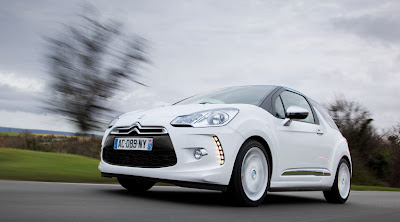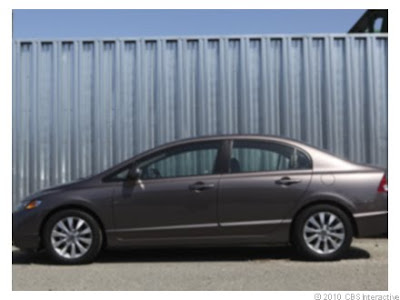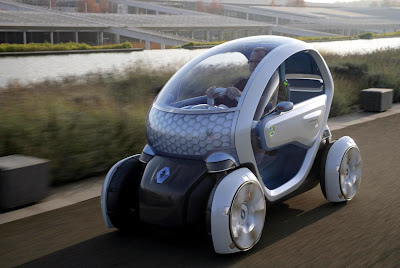The car itself sits firmly in the crossover segment. In style and shape, it resembles its big brother, the Infiniti FX. But the EX is shorter in length by almost a foot and in height by 3.5 inches. That may not sound like much, but the EX reads as a much smaller vehicle in person, and could almost be called a hatchback. Whereas the FX works well in suburbia, the EX is an excellent city car.
 |  |  |  |
One tech feature that particularly helps in the city is the around-view camera. Along with a rear-view, which includes trajectory and distance lines, our EX35 had side and front cameras that gave us a top-down look at the car.
Squeezing into a tight parallel parking spot, the camera view proved invaluable, letting us see the curb and the cars to the front and back, resulting in almost perfect parking. The front camera even showed trajectory lines as we eased the EX35 forward, edging up to the car in front. We could also switch the top-down view to a curb-side view, with a yellow line overlaid to help judge distance to the curb.
Infiniti calls the more radical technology in the EX35 Distance Control Assist (DCA). Using the forward-facing radar already in the car for the adaptive cruise control, DCA looks at traffic ahead, and applies the brakes and even pushes back on the gas pedal when cars ahead are stopped or slowing. For some, DCA will seem too intrusive. We used it extensively and found ourselves fighting the gas pedal pushback continually, as its idea of a safe stopping distance and ours differed in city traffic.
Still, we could see its usefulness. At times, as we looked to see if the next lane over was clear for a lane change, DCA slowed the EX35 in response to traffic ahead slowing. We also found it amusing to let it bring the EX35 to a stop as we approached traffic at a red light.
We could not, however, rely on the system to stop the car all the time. In city driving, the forward-facing radar seemed to get a fix on traffic ahead only about 50 percent of the time. We quickly learned to check the instrument cluster display for the little car icon that indicated whether it had a lock on the car ahead or not. DCA does not turn on by default; the driver must choose to turn it on by pushing a button on the steering wheel.
However, Forward Collision Warning, which also uses the car's radar, comes on automatically. This feature turns on an audible warning if it feels the EX35 is approaching stopped traffic too quickly. Less intrusive, the audible warning can be turned off.
More conventional is the adaptive cruise control, which, like systems from other automakers, matches the EX35's speed with slower traffic when the cruise control is set. We've grown to appreciate this type of cruise control, and made use of it while driving the EX35 on the freeway. Rather than fiddle with the cruise control or plan a lane change whenever we approached slower traffic in our lane, we just let the cruise control adjust our speed. If the car ahead was keeping up a reasonable pace, we settled in the lane.
Rounding out the driver aid technology is lane departure warning and prevention. Although we didn't encounter a situation in which these features would have proven useful, they can be invaluable on long road trips. When crossing a lane line without signaling, the car sounded an audible warning. If we let it continue to drift across the lane line, the EX35 nudged itself back into its lane by lightly braking the off-side wheels. When trying out this feature, it felt perfectly safe. IT never felt as though the car was about to make any violent moves.
Surprisingly, the one driver aid feature missing is one we've really liked in other cars: blind spot detection.
A time-tested engine
The 35 in the EX35 name signifies the 3.5-liter V-6 under the hood--a power plant that makes 297 horsepower and 253 pound-feet of torque. This engine will be familiar to those who follow the Infiniti and Nissan brands, as it has seen use in a wide variety of models, and appeared on Ward's 10 Best Engines list for many years running.
This engine proves more than adequate for motivating the EX35. It always felt ready to get the car off the line quickly. During a run up to freeway speeds, the engine showed no signs of lagging, continuing to give the car push up to and beyond the legal limit. During one passing run on the freeway, we looked down at the speedometer and noticed that the car was already up to 90 mph, showing how effortlessly it takes off.
Infiniti mates this engine to a five-speed automatic, which seems like an aberration in this car. The FX35, which gets the same engine and is built on the same platform, gets a seven-speed transmission. Infiniti might have chosen the five speed to save weight or to fit in a smaller space, but the result is higher engine speeds on the freeway.
Those higher engine speeds also mean worse fuel economy. The EPA rates the Infiniti EX35 with all-wheel-drive at 16 mpg city and 23 mpg highway. We've always found that Nissan and Infiniti cars with the 3.5-liter V-6 struggle to maintain fuel economy over 20 mpg, and the lack of a sixth gear does not help the EX35. In our testing we averaged 19.1 mpg.
The transmission has sport and manual modes, which both suited the car's performance-oriented handling. We raced the car over mountain roads to get a sense of how the transmission responded in its different modes, and found sport the most satisfying. Manual gear changes suffer from torque converter lag, but the sport mode did a good job of keeping the engine speed high for power in the turns. It is not as aggressive as some we've tested, but was well-suited to the car's ability to corner.
Like most Infiniti vehicles, the EX35 uses stabilizer bars to keep it settled in the turns. It doesn't go through the corners perfectly flat, but doesn't exhibit much roll, either. Our car's all-wheel-drive gave it an edge, as we could feel it digging in and aiding grip--especially useful to us since we were testing on wet roads.
Solid cabin tech
The power train proved to be the least high-tech aspect of the EX35, as our car came equipped with an impressive raft of cabin gadgets. Infiniti's hard-drive-based navigation system uses good-looking maps and shows some landmark buildings in 3D, although it doesn't go to quite the extreme of Audi's 3D rendering in the Q5.
This navigation system includes traffic and weather, and dynamically routes around traffic jams. We found it worked quickly, and showed very useful route guidance graphics, along with voice prompts that pronounced street names.
A combination of a touch-screen and a hardware controller made destination inputs easy. Infiniti uses one of our favorite interfaces, its knob studded with directional buttons that allows quick maneuvering around the various screens.
Infiniti reserves 9.3GB of space on the navigation hard drive for the car's Jukebox feature. We were able to rip CDs to the hard drive using the CD/DVD slot, and the car's internal Gracenote database correctly tagged the resulting MP3 files. There is also satellite radio and good iPod integration in the form of a USB port to which we plugged in an iPhone. This system also allows Bluetooth streaming.
The Bose audio system in the car uses 11 speakers, including two subwoofers and a center fill. The sound quality is very good, although not up to the level of some premium systems by THX and Mark Levinson. It produces a strong sound with solid bass, but the highs are not quite as distinct as we would like.
In sum
We were suitably blown away by the 2010 Infiniti EX35's cabin tech. The traditional features--navigation, stereo, and Bluetooth phone system--were all high quality, but the addition of the driver aid features pushes this car over the top. We love the around-view camera system, and the Distance Control Assistance was at least intriguing.
Although the power train and suspension did not push the tech envelope, they are well-engineered to make the EX35 a very enjoyable car to drive. We appreciated the compact dimensions and could see it as a comfortable multi-use vehicle. As for design, the cabin tech interface is attractive and one of the most usable we've seen. As for the exterior, the car cuts a pleasing profile, and is unmistakably an Infiniti.
Spec box
Model 2010 Infiniti EX35
Trim Journey
Powertrain 3.5-liter V-6 engine
EPA fuel economy 16 mpg city/23 mpg highway
Observed fuel economy 19.1 mpg
Navigation Hard drive-based with traffic
Bluetooth phone support Standard
Disc player MP3 compatible single CD/DVD player
MP3 player support iPod integration
Other digital audio Onboard hard drive, USB thumb drive, Bluetooth streaming audio, satellite radio
Audio system Bose 11 speaker system
Driver aids Rear view camera, around-view camera, side-camera, front camera, lane departure warning, lane departure prevention, adaptive cruise control, distance control
Base price $37,400
Price as tested $44,695
















